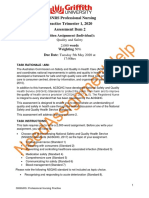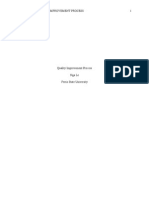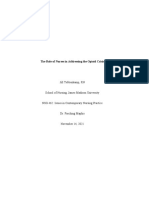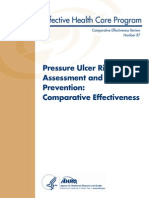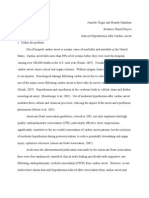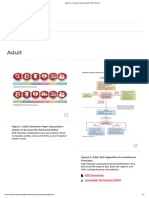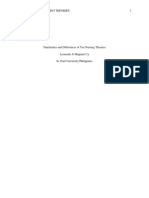Ebp Project Paper Summative - Dean
Ebp Project Paper Summative - Dean
Uploaded by
api-252790184Copyright:
Available Formats
Ebp Project Paper Summative - Dean
Ebp Project Paper Summative - Dean
Uploaded by
api-252790184Original Title
Copyright
Available Formats
Share this document
Did you find this document useful?
Is this content inappropriate?
Copyright:
Available Formats
Ebp Project Paper Summative - Dean
Ebp Project Paper Summative - Dean
Uploaded by
api-252790184Copyright:
Available Formats
Running head: DECREASING VAP
Decreasing Ventilator-Associated Pneumonia (VAP)
Chelsea Dean
University of South Florida
DECREASING VAP
2
Abstract
Ventilator-associated pneumonia (VAP) is one of the most common nosocomial infections in
mechanically ventilated hospitalized patients. Developing an intervention to decrease the
incidence of VAP in critically ill, mechanically ventilated adult patients will decrease patient
hospital stays, health care costs, and mortality rates. Research literature obtained for this project
proposal came from the search engines CINAHL EBSCOhost and PubMed. Key terms used
throughout the search process were ventilator-associated pneumonia and chlorhexidine. Research
literature consisted of three randomized controlled trials (RCTs) and one clinical guideline.
Research was found to cumulatively support the implementation of oral care using 0.12%
chlorhexidine (CHX) for critically ill, mechanically ventilated adult patients to decrease the
incidence of VAP. A pilot study, involving the implementation of a six-month intervention of
oral care including CHX amongst mechanically ventilated patients in the identified clinical
settings critical care units will be conducted based upon acquired research evidence. Process
evaluation and data collection will occur throughout the piloting period. Pilot data will be
analyzed and compared to pre-intervention data. If clinical significance is determined, the
identified setting will implement policy and protocol changes with the inclusion of CHX oral
care for the population of critically ill, mechanically ventilated adult patients. Dissemination of
the proposed practice change will occur both locally and regionally.
DECREASING VAP
3
Decreasing Ventilator-Associated Pneumonia (VAP)
Ventilator-associated pneumonia is one of the most common nosocomial infections in
mechanically ventilated hospitalized patients. According to Kimberly-Clark Health Care (2014),
VAP affects up to 28% of ventilated patients, and may account for up to 60% of all deaths from
healthcare-associated infections (HAIs) in the United States. The impact of VAP upon overall
patient outcomes is significant. VAP incidence can increase a patients ICU stay by 4-6 days, is
estimated to generate an increased cost of 20,000-40,000 dollars per hospital admission, and can
have a patient mortality rate of approximately 33% (Kimberly-Clark Health Care, 2014). Due to
the statistical significance associated with VAP in the clinical setting, the PICOT question
associated with this project is: In critically ill, mechanically ventilated adult patients, how does
the use of oral care including chlorhexidine compare to standard oral care (no chlorhexidine use)
in reducing the incidence of VAP over a six-month period? Specific infrastructure is essential in
supporting the change process necessary for project implementation in the clinical setting.
Infrastructure is considered a key element of a clinical settings development toward an
evidence-based culture (Melnyk & Fineout-Overholt, 2011). The infrastructure necessary to
support a change in the identified clinical setting relies heavily on interdisciplinary action.
Infectious disease physicians, critical care nurses and nurse managers, and a hospital
research/evidence-based practice (EBP) team are all pertinent team members for project
implementation.
Literature Search
Two search engines were utilized in the research required for this evidence-based project
CINAHL EBSCOhost and PubMed. The key terms used throughout the search process were
ventilator-associated pneumonia and chlorhexidine. Search limitations included a publication
DECREASING VAP
date range of 2008-2014, and the inclusion of randomized controlled trials and peer reviewed
journals only.
Literature Review
Grap and colleagues (2011) conducted a randomized controlled clinical trial (RCT)
related to trauma patients, to evaluate the use of an early (within 12 hours of intubation), single
application of 0.12% chlorhexidine by swab to the oral cavity in reducing microbial flora and
ventilator-associated pneumonia. The study sample was composed of a total of 145 patients 71
patients were randomly assigned to the intervention group and 74 to the control group.
Intervention group participants received one 5 mL dose of 0.12% CHX solution applied to the
oral cavity by swab within12 hours of intubation. Control group participants received standard
oral care that did not include the use of CHX. VAP was evaluated on admission, 48 hours, and
72 hours after intubation by using a Clinical Pulmonary Infection Score (CPIS). The CPIS
consists of six parameters: temperature, white blood cell count, tracheal secretions, oxygenation
(calculated by PAO2/FIO2), chest radiograph (radiologists report), and tracheal aspirate culture.
A significant treatment effect was found on CPIS both from admission to 48 hours (P = .020)
and to 72 hours (p = .027); 55.6% of the patients in the control group without pneumonia prior to
intubation developed VAP by 48 or 72 hours compared to only 33.3% of the intervention
patients (Grap et al., 2011). Strengths of the trial include: trial randomization, and the simple and
low cost intervention. A possible weakness of the trial is its relatively small sample size.
Kusahara and colleagues (2012) conducted a randomized-controlled trial to test the
efficacy of oral care with 0.12% chlorhexidine in decreasing ventilator-associated pneumonia in
critically ill children. The clinical trial was double-blinded and conducted in a pediatric critical
care unit over a 36 month period. The study sample was composed of a total of 96 mechanically
DECREASING VAP
ventilated children 50 children were randomly assigned to the placebo/control group and 46
children to the CHX/intervention group. Intervention group participants received twice daily oral
care with teeth brushing and a specific dental gel containing CHX. Control group participants
received twice daily oral care with teeth brushing and a placebo dental gel. The study used one
primary outcome measure, and five secondary outcomes. The primary outcome measure was the
development of VAP during the pediatric intensive care unit stay. Secondary outcomes included:
length of ventilation in the PICU, length of stay in the PICU, and hospital mortality and oral and
tracheal colonization with Gram-positive and Gram-negative microorganisms. Microbiological
analyses of oropharyngeal and tracheal secretions were performed 24, 48, and 96 hours after
intubation. Study results indicated a diagnosis of VAP in 32.6% of patients in the intervention
group, and 32.0% of patients in the control group (p = 0.949). While the use of 0.12%
chlorhexidine was found to not significantly modify the VAP incidence in a sample of
mechanically ventilated children, CHX use was found to be protective against VAP in children
without potentially pathogenic microflora in their oropharynx 24 hours after mechanical
ventilation (p = 0.019) (Kusahara, Peterlini, & Pedreira, 2012). Table 1 discusses further results
related to the studys secondary outcomes. Strengths of this trial include: trial randomization, a
double-blinded study, clear statement of primary and secondary outcomes, and similarity of both
groups demographics and baseline clinical variables. It is to be noted that while the population
sample of this study is children, and the project proposal is designed for adult patients, the study
provides complementary findings for the use of CHX as a protective intervention.
zaka and colleagues (2012) conducted a randomized double-blind controlled trial,
related to patients scheduled for invasive mechanical ventilation for at least 48 hours, to evaluate
the efficacy of oral swabbing with a 0.2% chlorhexidine gluconate solution in decreasing the risk
of acquiring ventilator-associated pneumonia. The study sample was composed of 61 patients
DECREASING VAP
29 patients were randomly assigned to the intervention group and 32 patients to the control
group. Intervention group participants received four-times daily oral care with CHX swabs.
Control group participants received four-times daily oral care with saline swabs each swabbing
session lasted one minute. The selected primary outcome measures of this study were incidence
of VAP and mortality. Secondary outcome measures assessed included: length of mechanical
ventilation, length of stay in the ICU, and the presence in mini bronchoalveolar lavage (miniBAL) of potential respiratory pathogens determined by quantifying colonies using standard
culture at each evaluation time-point. Results showed VAP rates significantly higher in the
control group when compared to the intervention group 68.8% versus 41.4% (p = 0.03)
(zaka et al., 2012). Table 1 discusses further results related to the studys secondary outcomes.
Strengths of the trial include: trial randomization, a double-blinded study, and the
appropriateness of the control group. It is also to be noted that this study was conducted in
Turkey CHX strength of 0.2% is not FDA approved in the U.S. at this time. While the higher
strength dose is not yet FDA approved, the interventions proven effectiveness in other countries
makes the studys inclusion appropriate for this proposal.
The Institute for Clinical Systems Improvement (ICSI) (2011) guideline objectives advocate
for elimination of ventilator-associated pneumonia in adult patients in an intensive care unit, and an
increase in the use of a ventilator-associated pneumonia bundle. Oral care with the use of
chlorhexidine in the prevention of VAP is included in the guidelines clinical recommendations. ICSI
(2011) dictates that a 0.2% CHX solution is effective in reducing the rate of VAP in mechanically
ventilated patients. While the guideline supports the use of CHX, a determined potential risk is
irritation of the oral mucus when higher solution rates are used resulting in a dose limiting effect.
Further clinical recommendations for the prevention of VAP discussed in the guideline include
elevation of the head of the bed, maintaining cuff pressure in the endotracheal tube between 20-25
DECREASING VAP
mmHg, stress ulcer disease prophylaxis, and deep vein thrombosis prophylaxis (Institute for Clinical
Systems Improvement, 2011). It is to be noted that the CHX solution strength recommended in this
clinical guideline is not FDA approved in the U.S. at this time.
Synthesis
While the research findings from the above articles show variance in regards to methods
used and outcomes achieved, together they ultimately show a certain level of success to support
the implementation of chlorhexidine oral care to critically ill, mechanically ventilated adult
patients in decreasing the incidence of ventilator-associated pneumonia. Of the three randomized
controlled trials utilized, the studies by zaka and colleagues (2012) and Grap and colleagues
(2011) achieved significantly lower rates of VAP in their adult intervention groups, while the
study done by Kusahara (2012) and colleagues found that the use of chlorhexidine did not
significantly modify the VAP incidence in a sample of mechanically ventilated children.
Although the study done by Kusahara and colleagues (2012) did not find success with
chlorhexidine amongst their intervention sample, chlorhexidine use was found to be protective
against VAP in children without potentially pathogenic microflora in their oropharynx 24 hours
after mechanical ventilation.
In regards to sample solution strength, the studies by Grap and colleagues (2011) and
Kusahara and colleagues (2012) both utilized 0.12% CHX, while 0.2% CHX strength was used
by zaka and colleagues (2012) and recommended by the ICSI clinical guidelines (2011). CHX
application routines amongst the intervention groups of all three RCTs varied. Patients in the
study by Kusahara and colleagues (2012) received twice daily oral care with CHX, patients in
the study by zaka and colleagues (2012) received four-times daily oral care with CHX, and
patients in the study by Grap and colleagues (2011) received a one-time application of CHX
within 12 hours of intubation. The one-time early CHX application intervention by Grap and
DECREASING VAP
colleagues (2011) demonstrated a lower incidence rate of VAP using both a weaker solution
strength and fewer applications when compared to the studies by zaka and colleagues (2012)
and Kusahara and colleagues (2012). Fewer CHX applications is also supported by the ICSI
clinical guidelines (2011), due to the potential risk of irritation to the oral mucus when a higher
solution rate is used.
The variance in solution strength by study indicates the possible need for further research
in relation to solution effectiveness. Another possible need for further research relates to sample
population and chlorhexidine effectiveness. The lack of efficacy noted in the intervention group
of the study conducted by Kusahara and colleagues (2012) demonstrates an information gap
amongst the population of mechanically ventilated children.
Proposed Practice Change
As synthesized above, current research and clinical practice guidelines recommend the
use of 0.12% chlorhexidine in the oral care of critically ill, mechanically ventilated adult patients
to reduce the incidence of ventilator-associated pneumonia. Recommendations include a onetime 5 mL application of 0.12% CHX to patients within 12 hours of intubation, followed by a
twice-daily 5 mL application regimen of 0.12% CHX throughout the entirety of patient
intubation. A pilot study, involving the implementation of a six-month intervention of oral care
including CHX amongst mechanically ventilated patients in the identified clinical settings
critical care units will be conducted based upon acquired research evidence. If clinical
significance is determined, the identified setting will implement policy and protocol changes
with the inclusion of this evidence-based practice (EBP).
Change Strategy
Promotion of an evidence-based culture within the clinical setting relies on the cultivation
of a spirit of inquiry a spirit of inquiry encourages all health professionals to question their
DECREASING VAP
current practices (Melnyk & Fineout-Overholt, 2011). Strategies to promote staff engagement
with EBP must utilize a trickle-down approach from the engagement of leadership to the
engagement of staff. Examples of strategies to engage the identified clinical settings leadership
include the hosting of educational luncheons for nurse managers and administrators, and monthly
educational classes it is vital to the success of an EBP project that it is supported by managers
with clearly identified benefits for a units population (Melnyk & Fineout-Overholt, 2011).
Strategies to promote staff engagement include journal clubs, poster presentations, and EBP
residencies (Melnyk & Fineout-Overholt, 2011).
The Iowa model of evidence-based practice to promote quality care will be utilized to
guide the implementation of this project. The Iowa model outlines a pragmatic multiphase
change process with feedback loops. The model is based on the problem-solving steps in the
scientific process and is widely recognized for its applicability and ease of use by
multidisciplinary healthcare teams (Melnyk & Fineout-Overholt, 2011). The Iowa model is
appropriate for the implementation of this specific project due to its historically proven
usefulness in practice and its interdisciplinary nature. The Iowa model guides clinicians through
the EBP process, and is designed to support evidence-based healthcare delivery by
interdisciplinary teams (Melnyk & Fineout-Overholt, 2011).
Roll Out Plan
May 2014 Identification of clinical problem: Rates of VAP in critically ill,
mechanically ventilated adult patients in the identified clinical setting. This topic
was deemed to be a priority issue for the setting.
DECREASING VAP
10
May 2014 Team formation: An EBP research team was assembled to develop,
implement, and evaluate the practice change necessary to decrease VAP incidence
in the identified clinical setting.
June 2014 Assemble relevant research and related literature/critique and
synthesize research for use in practice: The hospital research/EBP team gathered
relevant EBP literature and research on the topic of VAP prevention. The research
was critiqued and synthesized to determine setting-appropriate interventions. A
pilot study was developed for implementation within the clinical settings critical
care units.
July 2014-December 2014 Pilot the change in practice: Implementation of a sixmonth intervention of oral care including CHX amongst mechanically ventilated
adult patients in the identified clinical settings critical care units. Process
evaluation and data collection will occur throughout the piloting period.
January 2015 Evaluate/disseminate results: Pilot data will be analyzed and
compared to pre-intervention data. If clinical significance is determined, the
identified setting will implement policy and protocol changes with the inclusion
of CHX oral care for the population of critically ill, mechanically ventilated adult
patients. Dissemination of the proposed practice change will occur both locally
and regionally.
Project Evaluation
The rate of ventilator-associated pneumonia incidence among critically ill, mechanically
ventilated adult patients is the main outcome of interest in the proposed project. Accordingly, the
identified clinical setting will calculate and evaluate the reported rates of VAP amongst patients
DECREASING VAP
11
who received oral care including 0.12% chlorhexidine against patients who received standard
oral care during the six-month implementation period of the project. The literature and evidence
used throughout this proposal recorded an average decrease in VAP between intervention and
control groups by approximately 20-30%. Therefore, success of the identified clinical settings
intervention will be confirmed by a minimum decrease of VAP incidence by 20%. Critical care
nurses will implement the change by providing patient oral care with chlorhexidine, as well as
collecting data and documenting findings from assigned patient case loads. VAP diagnoses from
previous standard oral care hospital protocol will be compared against the six-month
chlorhexidine oral care intervention by the hospital research/EBP team.
Dissemination of EBP
Various methods will be employed to disseminate the determined practice change locally
and regionally, including poster presentations, podium/oral presentations, evidence-based grand
rounds, journal clubs, community meetings, and through publishing (Melnyk & FineoutOverholt, 2011). Due to the specificity of the clinical population studied throughout this project,
dissemination of this change is best adapted toward the critical care setting. Tailoring
presentations to critical care health professionals, and choosing to publish conducted research in
critical care journals are examples of population-specific methods. If dissemination is successful
in the identified clinical setting, local and regional medical facilities should utilize the above
stated methods in their specific dissemination practices.
DECREASING VAP
12
References
Grap, M., Munro, C. L., Hamilton, V., Elswick, R. K., Sessler, C. N., & Ward, K. R. (2011).
Early, single chlorhexidine application reduces ventilator-associated pneumonia in
trauma patients. Heart & Lung, 40(5), e115-22. doi:10.1016/j.hrtlng.2011.01.006
Institute for Clinical Systems Improvement. (2011). Prevention of ventilator-associated
pneumonia: Health care protocol. Bloomington, MN: Institute for Clinical Systems
Improvement
Kimberly-Clark Healthcare. (2014). Ventilator associated pneumonia. Retrieved from
http://www.kchealthcare.com/hai-watch/hai-threats-solutions/ventilator-associatedpneumonia.aspx
Kusahara, D., Peterlini, M., & Pedreira, M. (2012). Oral care with 0.12% chlorhexidine for the
prevention of ventilator-associated pneumonia in critically ill children: Randomised,
controlled and double blind trial. International Journal of Nursing Studies, 49(11), 13541363. doi:10.1016/j.ijnurstu.2012.06.005
Melnyk, B. M., & Fineout-Overholt, E. (2011). Evidenced-based practice in nursing &
healthcare: A guide to best practice (2nd ed.). Philadelphia, PA: Lippincott Williams &
Wilkins.
zaka, . ., Baolu, . K., Buduneli, N. N., Tabakan, M. S., Bacakolu, F. F., & Kinane,
D. F. (2012). Chlorhexidine decreases the risk of ventilator-associated pneumonia in
intensive care unit patients: A randomized clinical trial. Journal of Periodontal Research,
47(5), 584-592. doi:10.1111/j.1600-0765.2012.01470.x
DECREASING VAP
13
Table 1
Literature Review
Reference
Aims
Grap, M., Munro, C. L.,
Hamilton, V., Elswick,
R. K., Sessler, C. N., &
Ward, K. R. (2011).
Early, single
chlorhexidine
application reduces
ventilator-associated
pneumonia in trauma
patients. Heart & lung,
40(5), e115-22.
doi:10.1016/j.hrtlng.201
1.01.006.
To evaluate the
use of an early
(within 12 hours
of intubation),
single oral
application of
0.12%
chlorhexidine in
reducing
microbial flora
and ventilatorassociated
pneumonia in
adult trauma
patients.
Kusahara, D., Peterlini,
M., & Pedreira, M.
(2012). Oral care with
0.12% chlorhexidine for
the prevention of
ventilator-associated
pneumonia in critically
ill children:
Randomised, controlled
and double blind trial.
International Journal of
Nursing Studies, 49(11),
1354-1363.
doi:10.1016/j.ijnurstu.20
12.06.005
To test the
efficacy of oral
care with 0.12%
chlorhexidine in
decreasing
ventilatorassociated
pneumonia in
critically ill
children.
Design and
Measures
Randomized
controlled trial.
VAP was
evaluated on
admission, 48
hours, and 72
hours after
intubation by
using a
Clinical
Pulmonary
Infection Score
(CPIS).
Sample
Outcomes /
statistics
145
A significant
mechanically
treatment effect
ventilated adult was found on
trauma
CPIS both from
patients. 71
admission to 48
patients were
hours (P = .020)
randomly
and to 72 hours (p
assigned to the = .027). 55.6% of
intervention
the patients in the
group and 74
control group
to the control
without
group.
pneumonia prior to
intubation
developed VAP by
48 or 72 hours
compared to
33.3% of the
intervention
patients.
Double blinded 96
Study results
randomized
mechanically
indicated a
controlled trial. ventilated
diagnosis of VAP
Primary
children. 50
in 32.6% of
outcome
children were
patients in the
measure was
randomly
intervention group,
the
assigned to the and 32.0% of
development
placebo/control patients in the
of VAP during group and 46
control group (p =
the pediatric
children to the 0.949). While the
intensive care
CHX/interventi use of 0.12%
unit stay.
-on group.
chlorhexidine was
Secondary
found to not
outcomes
significantly
included:
modify the VAP
length of
incidence in a
ventilation in
sample of
the PICU,
mechanically
length of stay
ventilated children,
in the PICU,
CHX use was
DECREASING VAP
14
and hospital
mortality and
oral and
tracheal
colonization
with Grampositive and
Gram-negative
microorganism
s.
zaka, . ., Baolu,
. K., Buduneli, N. N.,
Tabakan, M. S.,
Bacakolu, F. F., &
Kinane, D. F. (2012).
Chlorhexidine decreases
the risk of ventilatorassociated pneumonia in
intensive care unit
patients: A randomized
clinical trial. Journal of
Periodontal Research,
47(5), 584-592.
doi:10.1111/j.16000765.2012.01470.x
To evaluate the
efficacy of oral
swabbing with a
0.2%
chlorhexidine
gluconate
solution in
decreasing the
risk of acquiring
ventilatorassociated
pneumonia in
patients
scheduled for
invasive
mechanical
ventilation for at
least 48 hours.
Double blinded
randomized
controlled trial.
Primary
outcome
measures of
this study were
incidence of
VAP and
mortality.
Secondary
outcome
measures
assessed
included:
length of
mechanical
ventilation,
length of stay
in the ICU, and
the presence in
mini-BAL of
potential
61 dentate
patients
admitted to a
respiratory
ICU and
scheduled for
invasive
mechanical
ventilation for
at least 48
hours. 29
patients were
randomly
assigned to the
intervention
group and 32
patients to the
control group.
found to be
protective against
VAP in children
without potentially
pathogenic
microflora in their
oropharynx 24
hours after
mechanical
ventilation (p =
0.019). The
intervention did
not influence
secondary
outcomes of
pediatric intensive
care unit mortality
(p = 0.425),
hospital length of
stay (p = 0.143), or
pediatric intensive
care unit length of
stay (p = 0.177).
Results showed
VAP rates
significantly
higher in the
control group
when compared to
the intervention
group 68.8% vs.
41.4% (p = 0.03).
No significant
differences could
be demonstrated in
the secondary
outcomes of the
length of ICU stay,
duration of
hospitalization,
and mechanical
ventilation
between the
intervention and
control groups.
DECREASING VAP
15
respiratory
pathogens
determined by
quantifying
colonies using
standard
culture at each
evaluation
time-point.
You might also like
- SJT Practice Paper Large Print PDFDocument83 pagesSJT Practice Paper Large Print PDFRumaisha Nuha ZNo ratings yet
- iCARE PAPER Revised..editedDocument7 pagesiCARE PAPER Revised..editedMoffat HarounNo ratings yet
- 2melnyk Ebp The Seven StepsDocument3 pages2melnyk Ebp The Seven Stepsapi-272725467100% (1)
- Review of System (ROS)Document6 pagesReview of System (ROS)Abdul Hamid Alraiyes0% (1)
- 4melnyk Ebp Search For EvidenceDocument7 pages4melnyk Ebp Search For Evidenceapi-272725467No ratings yet
- Ati RN 2016 Mental HealthDocument6 pagesAti RN 2016 Mental HealthStan Tan0% (1)
- Clinical Question Final PaperDocument13 pagesClinical Question Final Paperapi-253509573No ratings yet
- 3806NRS Nursing Assignment HelpDocument5 pages3806NRS Nursing Assignment HelpMarry WillsonNo ratings yet
- Nurs 440, Quality Improvement Process Paper, Fall 2014Document8 pagesNurs 440, Quality Improvement Process Paper, Fall 2014api-253664398No ratings yet
- PATHOPHYSIOLOGY TemplateDocument1 pagePATHOPHYSIOLOGY TemplateMargareth GonzalesNo ratings yet
- Med HostDocument4 pagesMed HostNitika13No ratings yet
- 4 10 18 306 Transcultural PaperDocument6 pages4 10 18 306 Transcultural Paperapi-488513754No ratings yet
- The Antidote to Suffering: How Compassionate Connected Care Can Improve Safety, Quality, and ExperienceFrom EverandThe Antidote to Suffering: How Compassionate Connected Care Can Improve Safety, Quality, and ExperienceNo ratings yet
- Y Yyy Y Yyy Y YY Y Yy Yyy Y ! YY"Y#Y$Y# Y Y % Y &Y'Y (Y) +#Y"Y Y Y, Yyyy-Yyy Y.Y Y Y/Y "Y.Y Y Y YDocument15 pagesY Yyy Y Yyy Y YY Y Yy Yyy Y ! YY"Y#Y$Y# Y Y % Y &Y'Y (Y) +#Y"Y Y Y, Yyyy-Yyy Y.Y Y Y/Y "Y.Y Y Y Ydoni007No ratings yet
- Ambulatory Care, Acute and Critical CareDocument18 pagesAmbulatory Care, Acute and Critical CareGeeta Thakur100% (1)
- AnesthesiologyDocument18 pagesAnesthesiologyCarlos HernándezNo ratings yet
- Ebp PaperDocument8 pagesEbp Paperapi-250304529No ratings yet
- Interprofessional Practice in Nursing 1Document7 pagesInterprofessional Practice in Nursing 1gabrielNo ratings yet
- The New Rapid ResponderDocument3 pagesThe New Rapid RespondersarahNo ratings yet
- Outcomes of Ebp Process 2017Document3 pagesOutcomes of Ebp Process 2017api-272725467100% (1)
- Nurses Opioid CrisisDocument8 pagesNurses Opioid Crisisapi-523012644No ratings yet
- Policy Evaluation PaperDocument14 pagesPolicy Evaluation Paperapi-534245869No ratings yet
- Concept AnalysisDocument18 pagesConcept AnalysisRolan MangiwetNo ratings yet
- Handoffs - Implications For NursesDocument48 pagesHandoffs - Implications For Nursesaellenberg3755No ratings yet
- Eliminating CLABSI, A National Patient Safety ImperativeDocument19 pagesEliminating CLABSI, A National Patient Safety Imperativekcochran50% (2)
- CAUTI PresentationDocument77 pagesCAUTI PresentationYahia HassaanNo ratings yet
- Board Certified Nurse Practitioner in Savannah GA Resume Michele StephensDocument4 pagesBoard Certified Nurse Practitioner in Savannah GA Resume Michele StephensMicheleStephens100% (1)
- Case Log FNP 1Document6 pagesCase Log FNP 1natalie nodayNo ratings yet
- POC and Concepts Maps Week 12Document23 pagesPOC and Concepts Maps Week 12Michelle CollinsNo ratings yet
- 1 Integrative Review of LiteratureDocument19 pages1 Integrative Review of Literatureapi-531458194No ratings yet
- Picot Synthesis SummativeDocument14 pagesPicot Synthesis Summativeapi-259394980No ratings yet
- Running Head: Scope of Practice Is State Regulated 1Document7 pagesRunning Head: Scope of Practice Is State Regulated 1Carole MweuNo ratings yet
- The Madeleine TheoryDocument4 pagesThe Madeleine Theoryselina_kollsNo ratings yet
- Pressure Ulcer Prevention Report 130528Document358 pagesPressure Ulcer Prevention Report 130528Agung GinanjarNo ratings yet
- EBP Paper FinalDocument5 pagesEBP Paper FinalBrittney Dunn100% (1)
- EBP & ResearchDocument6 pagesEBP & ResearchangieswensonNo ratings yet
- Acls GuidelineDocument10 pagesAcls GuidelineReynaldoBinsarNo ratings yet
- Management of Vacuum Assisted Closure TherapyDocument14 pagesManagement of Vacuum Assisted Closure TherapyVoiculescu MihaelaNo ratings yet
- Ethics - Nursing Shortage IssueDocument7 pagesEthics - Nursing Shortage Issueapi-355702962No ratings yet
- Change InitiativeDocument7 pagesChange InitiativeWajiha ShaikhNo ratings yet
- Lack of Teamwork Poor Patient Saticfaction - Paper 1Document6 pagesLack of Teamwork Poor Patient Saticfaction - Paper 1api-314968337No ratings yet
- Funds Study Guide 29Document29 pagesFunds Study Guide 29Vin Lorenzo CampbellNo ratings yet
- Running Head: WINDSHIELD SURVEY 1Document14 pagesRunning Head: WINDSHIELD SURVEY 1rblair01100% (1)
- Interdisciplinary Nursing DocumentationDocument6 pagesInterdisciplinary Nursing Documentationgrace_nakateNo ratings yet
- TB QuestionnaireDocument1 pageTB QuestionnaireaplesgjskNo ratings yet
- CDC Eval ManualDocument103 pagesCDC Eval ManualMihaiisvoranuNo ratings yet
- Ten Nursing TheoryDocument13 pagesTen Nursing TheoryleiNo ratings yet
- Development of A Tool For Pressure Ulcer Risk Assessment and PrevDocument165 pagesDevelopment of A Tool For Pressure Ulcer Risk Assessment and PrevEASACOLLEGENo ratings yet
- Integrated Management of Childhood IllnessDocument2 pagesIntegrated Management of Childhood IllnessMariah Jane TaladuaNo ratings yet
- Waiters Osteoarthritis PDFDocument1 pageWaiters Osteoarthritis PDFTommieNo ratings yet
- Sepsis: Pathophysiology and Management in The ICUDocument38 pagesSepsis: Pathophysiology and Management in The ICUprashsubbuNo ratings yet
- Paying More To Live The Life of A Diabetic 2Document6 pagesPaying More To Live The Life of A Diabetic 2api-550314683No ratings yet
- Chief Nursing Officer in USA Resume Prissana AlstonDocument3 pagesChief Nursing Officer in USA Resume Prissana AlstonPrissanaAlston100% (1)
- Issue 29 - The Nurse Advocate - Hamad Medical Corporation - April 2017Document20 pagesIssue 29 - The Nurse Advocate - Hamad Medical Corporation - April 2017Brent ForemanNo ratings yet
- Anatomy RespDocument57 pagesAnatomy RespGunawan SamosirNo ratings yet
- Technologies Designed To Help Improve Patients OutcomeDocument53 pagesTechnologies Designed To Help Improve Patients OutcomeHarby Ongbay AbellanosaNo ratings yet
- Congenital Heart DefectsDocument1 pageCongenital Heart DefectsTori IkeharaNo ratings yet
- Stroke Clinical PathwayDocument1 pageStroke Clinical PathwayKanoknun PisitpatcaragulNo ratings yet
- Normal DIE CPP Calculations:: Increased Intracranial Pressure (Cerebral Perfusion Pressure)Document79 pagesNormal DIE CPP Calculations:: Increased Intracranial Pressure (Cerebral Perfusion Pressure)Nur SanaaniNo ratings yet
- Critical Analysis: Skills by Stella Cottrell (2005, Palgrave Macmillan) Extremely Useful. in TheDocument11 pagesCritical Analysis: Skills by Stella Cottrell (2005, Palgrave Macmillan) Extremely Useful. in ThelisastricklandNo ratings yet
- 3melnyk Ebp Asking Clinical QuestionDocument4 pages3melnyk Ebp Asking Clinical Questionapi-272725467No ratings yet
- Fundamentals Pat Part 3 - Dean GradedDocument22 pagesFundamentals Pat Part 3 - Dean Gradedapi-252790184No ratings yet
- Pat 2 Med Surg - Dean GradedDocument24 pagesPat 2 Med Surg - Dean Gradedapi-252790184No ratings yet
- Final Clinical Evaluation - FundamentalsDocument8 pagesFinal Clinical Evaluation - Fundamentalsapi-252790184No ratings yet
- Portfolio Clinical ExemplarDocument5 pagesPortfolio Clinical Exemplarapi-25279018433% (3)
- Portfolio Personal GoalsDocument2 pagesPortfolio Personal Goalsapi-252790184No ratings yet
- DR Suhendro - Sepsis SOLODocument25 pagesDR Suhendro - Sepsis SOLOOlivia DwimaswastiNo ratings yet
- MNT For Critically Ill and Burn InjuryDocument53 pagesMNT For Critically Ill and Burn Injurydibra htsNo ratings yet
- Critical Care Nursing: A Holistic Approach Eleventh, North American Edition All Chapters Instant DownloadDocument55 pagesCritical Care Nursing: A Holistic Approach Eleventh, North American Edition All Chapters Instant Downloadyutaomaleru100% (1)
- Laura Coffee CV 2021Document3 pagesLaura Coffee CV 2021api-581047004No ratings yet
- Pacu Cover LetterDocument6 pagesPacu Cover Letterbcr9srp4100% (2)
- Critical Care NursingDocument46 pagesCritical Care Nursingraquel_racoNo ratings yet
- Does Early Mobility For Mechanically Ventilated Patients in The ICU Reduce Hospitalization Time?Document7 pagesDoes Early Mobility For Mechanically Ventilated Patients in The ICU Reduce Hospitalization Time?Shirley VanNo ratings yet
- PDF Trauma Care Manual (Third Edition) Ian Greaves (Editor) DownloadDocument49 pagesPDF Trauma Care Manual (Third Edition) Ian Greaves (Editor) Downloaddeppigazzy100% (4)
- LucknowDocument52 pagesLucknowa k singhNo ratings yet
- Pradhan & SresthaDocument4 pagesPradhan & Srestharengga.telkomedikaNo ratings yet
- Critical Care NurseDocument2 pagesCritical Care NurseMariCris CaronanNo ratings yet
- Ajtr0014 4757Document20 pagesAjtr0014 4757Eyal RobinsonNo ratings yet
- Essentials of Critical Care Nursing (gnv64) PDFDocument537 pagesEssentials of Critical Care Nursing (gnv64) PDFMohammad Tayyab Khan100% (2)
- A Nomogram For The Interpretation of Acid-Base Data: Summary: A Diagnostic Nomogram Based On Log pCODocument4 pagesA Nomogram For The Interpretation of Acid-Base Data: Summary: A Diagnostic Nomogram Based On Log pCOCARLOS FRANCISCO MANTILLA MONTALVONo ratings yet
- ETT SUCTION DEWASA ACI14 - Suction - 2-2 PDFDocument46 pagesETT SUCTION DEWASA ACI14 - Suction - 2-2 PDFAde Rahmah YuliaNo ratings yet
- PDFDocument34 pagesPDFmohanssec mohanNo ratings yet
- Choice Between Gastrostomy and JejunostomyDocument22 pagesChoice Between Gastrostomy and JejunostomyJonel BuenaventuraNo ratings yet
- Katya Kirkland ResumeDocument1 pageKatya Kirkland Resumeapi-643862582No ratings yet
- Problems of Psychology in The 21st Century, Vol. 16-2, 2022Document45 pagesProblems of Psychology in The 21st Century, Vol. 16-2, 2022Scientia Socialis, Ltd.No ratings yet
- Naloxone in AdultsDocument8 pagesNaloxone in AdultsRoboschi StefaniaNo ratings yet
- Attitude Towards Safety Culture Among Employees at The Intensive Care Unit in The Governmental Hospital of Gaza CityDocument129 pagesAttitude Towards Safety Culture Among Employees at The Intensive Care Unit in The Governmental Hospital of Gaza CityParasmentoNo ratings yet
- Presentasi Dr. Basuki Rachmad, Sp. An. KICDocument39 pagesPresentasi Dr. Basuki Rachmad, Sp. An. KICinstalasi kamar bedah RSMINo ratings yet
- 1 Updated Nan Report MergedDocument35 pages1 Updated Nan Report Mergedabhishek.1660kvsrodelhi.inNo ratings yet
- Instant Access To Critical Heart Disease in Infants and Children 3rd Edition Ross M. Ungerleider - Ebook PDF Ebook Full ChaptersDocument41 pagesInstant Access To Critical Heart Disease in Infants and Children 3rd Edition Ross M. Ungerleider - Ebook PDF Ebook Full Chaptersxiaohefiamor100% (3)
- AccreditationReadiness Booklet (Version 1.0) - May 2022Document44 pagesAccreditationReadiness Booklet (Version 1.0) - May 2022Leon GuerreroNo ratings yet
- NRLS 1051 Potassium PSA 2002 10 31 v1Document6 pagesNRLS 1051 Potassium PSA 2002 10 31 v1Ken CheungNo ratings yet







